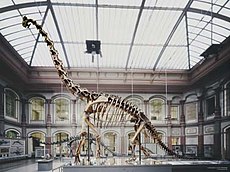Brachiosaur
| Brachiosaurs Temporal range: Upper Jurassic – Lower Cretaceous
| |
|---|---|

| |
| Mounted skeleton of Giraffatitan in Berlin. | |
| Scientific classification | |
| Kingdom: | |
| Phylum: | |
| Class: | |
| Order: | |
| Suborder: | |
| Infraorder: | |
| Family: | Brachiosauridae
|
| Genera | |
Brachiosaurs are a family of sauropod dinosaurs, the Brachiosauridae.[1] They were herbivorous quadrupeds with longer forelegs than hind legs. As a result, there is also some dispute about which animals belong within this family.
The largest mounted skeleton in the world is a brachiosaur, the Giraffatitan brancai (formerly Brachiosaurus brancai) at the Museum für Naturkunde in Berlin, Germany.
Brachiosaurs first evolved in the Middle Jurassic,[2] and died out at the end of the Lower Cretaceous, surviving for about 60 million years. The earliest known brachiosaur may be Lapparentosaurus from the Middle Jurassic of Africa. The giant Sauroposeidon from North America was one of the last brachiosaurs, living just before the end of the Early Cretaceous period.
The name "brachiosaur" means "arm lizard", which may sound like a strange name for a four-legged animal. The family Brachiosauridae was given this name because the dinosaurs in it tended to have longer "arms" (front legs) than back legs.
In popular culture[change | change source]
Brachiosaurs have been featured in many works of popular culture, particularly the type genus, Brachiosaurus. Brachiosaurus was featured in the 1993 film Jurassic Park, as well as the 2000 Disney film Dinosaur. The brachiosaur Astrodon is the state dinosaur of Maryland. It was featured in paleontologist Robert T. Bakker's novel Raptor Red, where it was portrayed as a prey item of the dromaeosaur Utahraptor.
